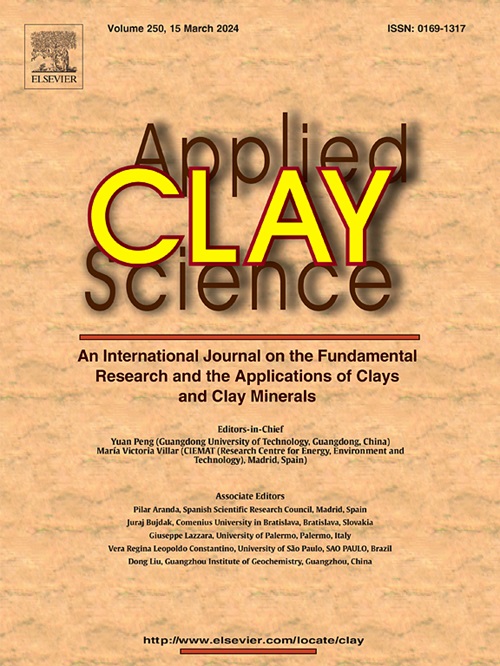Tuning the synthesis of aluminosilicates to enhance metal cation uptake for heavy metal immobilization
IF 5.8
2区 地球科学
Q2 CHEMISTRY, PHYSICAL
引用次数: 0
Abstract
Many aluminosilicates are characterized by a pronounced ability to bind heavy metals from aqueous solutions. This work demonstrates the great potential and adaptability of clay materials for use in the emerging field of in-situ groundwater remediation of heavy metals. The synthesis of aluminosilicates was adapted to achieve the highest possible uptake affinity and capacity for Co2+, Cu2+ and Ni2+. This optimization enabled maximum loadings of up to 1.1 mol Me2+ kg−1 and KD values well above 3000 L kg−1. Elevated temperatures during synthesis or drying lead to reduced uptake affinity for metals, e.g., by the factor of 3 for Ni2+ when changing drying temperature from 100 °C to room temperature. On the one hand, metal uptake takes place via interaction with variable surface charges, which is strongly pH-dependent and more pronounced for Cu2+. On the other hand, there is also a certain degree of interaction with permanent surface charges through isomorphous substitution leading to more stable bonds. Individual experiments showed comparable uptake of the various metals with 0.6 mol kg−1 at pH 3 up to 1.1 mol kg−1 at pH 5. However, Ni2+ was preferably taken up in direct competition with the other metals. Thanks to the simple low-temperature synthesis, the high metal loadings and robust metal uptake achieved even at low pH, amorphous aluminosilicates represent a valuable alternative to other products for heavy metal removal from aqueous solution. Future research should focus on their interaction with different metals simultaneously and metal uptake in flow-through systems.

调整硅铝酸盐的合成以提高重金属固定化中金属阳离子的吸收
许多铝硅酸盐的特点是具有从水溶液中结合重金属的显著能力。这项工作证明了粘土材料在地下水重金属原位修复这一新兴领域的巨大潜力和适应性。硅铝酸盐的合成对Co2+、Cu2+和Ni2+具有最高的吸附亲和力和吸附能力。该优化使最大负载高达1.1 mol Me2+ kg - 1, KD值远高于3000 L kg - 1。在合成或干燥过程中升高的温度导致对金属的吸收亲和力降低,例如,当将干燥温度从100°C改变到室温时,对Ni2+的吸收亲和力降低了3倍。一方面,金属的吸收是通过与可变表面电荷的相互作用进行的,这种相互作用强烈依赖于ph,对Cu2+来说更为明显。另一方面,也有一定程度的相互作用与永久表面电荷通过同构取代导致更稳定的键。个别实验表明,在pH 3下,各种金属的吸收量为0.6 mol kg - 1,在pH 5下为1.1 mol kg - 1。然而,Ni2+最好与其他金属直接竞争。由于简单的低温合成,即使在低pH值下也能实现高金属负载和强劲的金属吸收率,无定形铝硅酸盐代表了从水溶液中去除重金属的其他产品的有价值的替代品。未来的研究应集中在它们与不同金属的同时相互作用以及在流动系统中的金属吸收上。
本文章由计算机程序翻译,如有差异,请以英文原文为准。
求助全文
约1分钟内获得全文
求助全文
来源期刊

Applied Clay Science
地学-矿物学
CiteScore
10.30
自引率
10.70%
发文量
289
审稿时长
39 days
期刊介绍:
Applied Clay Science aims to be an international journal attracting high quality scientific papers on clays and clay minerals, including research papers, reviews, and technical notes. The journal covers typical subjects of Fundamental and Applied Clay Science such as:
• Synthesis and purification
• Structural, crystallographic and mineralogical properties of clays and clay minerals
• Thermal properties of clays and clay minerals
• Physico-chemical properties including i) surface and interface properties; ii) thermodynamic properties; iii) mechanical properties
• Interaction with water, with polar and apolar molecules
• Colloidal properties and rheology
• Adsorption, Intercalation, Ionic exchange
• Genesis and deposits of clay minerals
• Geology and geochemistry of clays
• Modification of clays and clay minerals properties by thermal and physical treatments
• Modification by chemical treatments with organic and inorganic molecules(organoclays, pillared clays)
• Modification by biological microorganisms. etc...
 求助内容:
求助内容: 应助结果提醒方式:
应助结果提醒方式:


